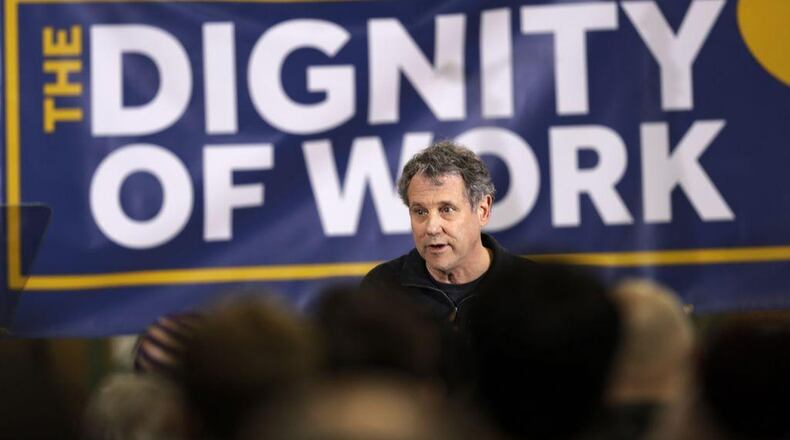Brown was the only Democrat on the statewide ballot last November in Ohio to win outside of the Supreme Court races.
As the tour kicked off Wednesday night in Cleveland, Brown said he doesn’t see his potential candidacy as solely geared to the Midwest.
Related: Brown’s everyman appeal has some pushing him to run for president
“I think it’s an appeal to working-class voters from all regions and of all races,” Brown said, describing his message as a product of “who I am and my whole career,” not shaped by “focus groups.”
Would you vote for Ohio Sen. @SherrodBrown for president if he decides to run? https://t.co/MZdmiBQgAZ
— Ohio Politics (@Ohio_Politics) January 31, 2019
Brown’s visit to Iowa, the state that hosts the first 2020 presidential caucuses, began Thursday evening in small-town Cresco, in the one county in the nation both Democrat Barack Obama and Republican Donald Trump won by at least 20 percentage points.
Like Ohio, where Trump won in 2016 on the strength of working-class voters, Brown’s stops on his three-day Iowa itinerary underscore his central argument as a potential 2020 presidential contender: That he understands economically challenged Midwestern voters who helped make Trump president.
Several of Brown’s planned Iowa stops are in counties carried by Obama in 2008 and Trump in 2016, and all of them in places that have shed thousands of manufacturing jobs in recent decades.
Several Democrats have already announced they are running for president including Sen. Elizabeth Warren, D-Mass.; Sen. Kamala Harris, D-Calif.; Sen. Kirsten Gillibrand, D-NY; and former San Antonio mayor and HUD Secretary Julian Castro. Two well-established candidates yet to make their plans known are former Vice President Joe Biden and Sen. Bernie Sanders, I-Vermont.
But what kind of chance does Brown stand in a crowded, contentious and competitive Democratic primary field? We asked experts to give us five reasons Brown has a shot and five reasons he does not.
Kyle Kondik, University of Virginia, managing editor of Sabato’s Crystal Ball:
Pros:
* Brown is a mainstream Democrat who does not have any obvious quarrel with wings of the party.
* As a Midwesterner, he can make a compelling argument about electability.
* Unlike other contenders, he has long been consistent on many of his positions.
* He has a national presence with donors.
* Around for decades, he has been vetted.
Cons:
* He is a straight, white male and Dems may want to nominate someone who isn’t.
* For now, Brown lacks star power that can fuel small-donor money or attention-grabbing headlines.
* If he wins, Republican Gov. Mike DeWine gets to name is replacement in the U.S. Senate.
* He will have to deal with domestic violence allegations made against him during his divorce from his first wife.
* He has been in Congress for more than a quarter century – invariably, there will be aspects of his voting record that could come up that he would have to defend.
Mark Caleb Smith, Cedarville University:
Pros:
* Brown is Midwestern with experience running and winning statewide in an important swing state.
* Unless Amy Klobuchar, D-Minn., decides to run, Brown could be unusual.
* Brown has cultivated an image of speaking to blue collar social and economic values.
* His mainstream, traditional platform would be safe for general election Democrats. He can speak with authority to voters in Ohio, Michigan, Wisconsin and Pennsylvania.
* In the Senate, he’s been more ‘workhorse’ than ‘showhorse’ and has accomplishments he can point to.
Cons:
* Brown would be a middle-aged white man running against trendier candidates.
* Brown may not be able to break out of the pack if 10 or 20 candidates declare.
* Brown is plenty liberal according to his record, but can he become the darling of the left-wing?
* Image sells in national campaigns and Brown could be up against tough competition.
* Trump is visceral and pointed so Democrats may seek a candidate more in Trump’s media mold.
Meanwhile, former Ohio governor John Kasich, a Republican, is keeping up a national presence and considering a third run for president.
Related: Kasich makes debut as CNN contributor
The last time two Ohioans ran against one another in a presidential general election was November 1920 when Republican Warren Harding beat Democrat James M. Cox. Both men were newspaper publishers.
Information from the Associated Press is included in this report.
About the Author

